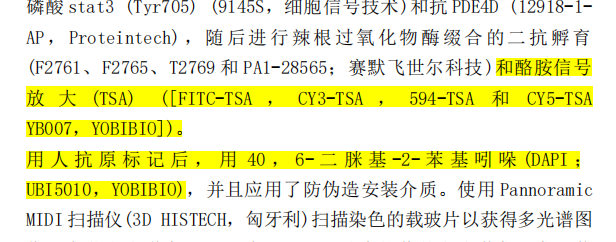杂志名称:Cell Proliferation
影响因子:5.9
文章题目:Single-nucleus transcriptomics reveals subsets of degenerative myonuclei after rotator cuff tear-induced muscle atrophy
DOI:https://doi.org/10.1111/cpr.13763
第一作者:Ziying Sun, Xi Cheng, Zheng Wang, Chenfeng Qiao, Hong Qian, Tao Yuan, Zhongyang Lv, Wenshuang Sun, Hanwen Zhang, Yuan Liu, Zhihao Lu, Jintao Lin, Chengteng Lai, Yang Wang, Xiaojiang Yang, Xingyun Wang, Jia Meng, Nirong Bao
作者单位:
南京大学医学院附属医院南京金陵医院
市南京大学医学院附属医院南京鼓楼医院
南京大学药物生物技术国家重点实验室
南京中医药大学金陵临床医学院
上海交通大学医学院附属同仁医院虹桥国际医学研究所
引用YOBIBIO产品:
YB007 四标多重免疫荧光试剂盒
UBI5010 40,6-二脒基-2-苯基吲哚(DAPI )
文章摘要:
Rotator cuff tear (RCT) is the primary cause of shoulder pain and disability and frequently trigger muscle degeneration characterised by muscle atrophy, fatty infiltration and fibrosis. Single-nucleus RNA sequencing (snRNA-seq) was used to reveal the transcriptional changes in the supraspinatus muscle after RCT. Supraspinatus muscles were obtained from patients with habitual shoulder dislocation (n = 3) and RCT (n = 3). In response to the RCT, trajectory analysis showed progression from normal myonuclei to ANKRD1+ myonuclei, which captured atrophy-and fatty infiltration-related regulons (KLF5, KLF10, FOSL1 and BHLHE40). Transcriptomic alterations in fibro/adipogenic progenitors (FAPs) and muscle satellite cells (MuSCs) have also been studied. By predicting cell–cell interactions, we observed communication alterations between myofibers and muscle-resident cells following RCT. Our findings reveal the plasticity of muscle cells in response to RCT and offer valuable insights into the molecular mechanisms and potential therapeutic targets of RCT.
肩袖撕裂 (RCT) 是肩部疼痛和残疾的主要原因,经常引发以肌肉萎缩、脂肪浸润和纤维化为特征的肌肉退化。单核 RNA 测序 (snRNA-seq) 用于揭示 RCT 后冈上肌的转录变化。冈上肌来自习惯性肩脱位 (n = 3) 和 RCT (n = 3) 患者。作为对 RCT 的反应,轨迹分析显示从正常肌核进展到 ANKRD1+ 肌核,后者捕获了萎缩和脂肪浸润相关的调节子 (KLF5 、 KLF10 、 FOSL1 和 BHLHE40)。还研究了纤维/成脂祖细胞 (FAP) 和肌肉卫星细胞 (MuSC) 的转录组改变。通过预测细胞间相互作用,我们观察到 RCT 后肌纤维和肌肉驻留细胞之间的通讯改变。我们的研究结果揭示了肌肉细胞响应 RCT 的可塑性,并为 RCT 的分子机制和潜在治疗靶点提供了有价值的见解。

